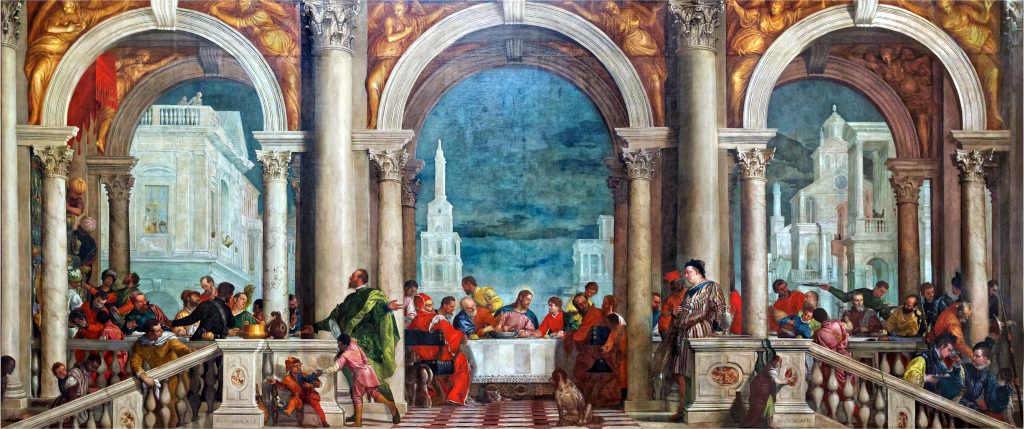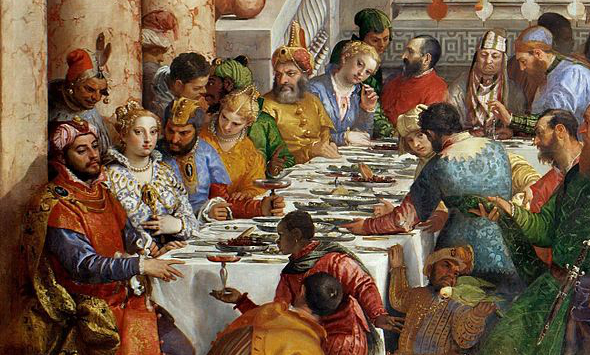Art is communication and needs no interpreter. However, there can be histories, anecdotes, and observations that add another dimension to our enjoyment once the artwork has spoken to us. And so it is with Veronese’s “Wedding at Cana.”
Paolo Caliari (1528 – 88), called Veronese after his native town of Verona, painted this theatrical biblical scene in 1562 – 63 for the refectory at the Benedictine monastery of S. Giorgio Maggiore in Venice where it inspired the monks until 1798 when Napoleon purloined it and other masterpieces during his conquest of Italy. The painting is so enormous (21.5 x 32.5 feet or 6.55 x 9.91 meters) that it had to be cut in the middle horizontally so that it could be transported to its new home in the Louvre.
After Napoleon’s fall, the Neo-Classical sculptor Antonio Canova (1757 – 1822) came to Paris in 1815 as the head of the commission to restore the stolen works to their prior homes. When it was argued that “The Wedding at Cana” should not suffer the necessary division to return it to Venice, Canova agreed and took a not quite so large painting by Charles Lebrun (1619 – 90) in exchange. Thus, we have “The Wedding at Cana” in the Louvre where its finesse of color has influenced artists from Delacroix to Matisse.

The Wedding at Cana. Paolo Caliari (1528 – 88), called Veronese, Musée du Louvre
At first, the scene is too much to take in beyond a wealth of color and characters in the palace courtyard setting, but slowly you start to focus (figure 1).
Veronese has shared the first miracle of Jesus only with us, the spectators, and the two servants right and left who see the liquid changing color as it is poured from the water urns unto the wine ewers. The participants of the feast have no idea since the manifestation of the miracle is in the foreground and only we can see the servant at work. The host, in white, has his head tilted in slight puzzlement as he studies the new fine wine, while on the far left, a servant is presenting a glass to the groom (details 1 & 3).



Jesus and Mary, though seated at the middle of the table and identified easily by their iconic halos and simple attire, are wonderfully subtle amid the display of finery and activity (detail 2).
Examining more closely the individual faces, you realize that though some have an idealized look, many are obvious portraits as was the custom. For example, the host was Veronese’s brother, Benedetto, also an artist (detail 1). The marked resemblance of the host to the other figure in white is no coincidence; this musician is a self-portrait (detail 2). Veronese has surrounded himself with his peers. The other musician just behind and to our right, also playing the viola de braccio is Tintoretto (1518 – 94). In red and playing the viola da gamba is Titian (1487/90 – 1576). Some books have indicated that the flautist is Jacopo Bassano (1510/18 – 92), but that is incorrect as Bassano would have been too old at that time to be mistaken for the young flautist.
Now switch your attention to the balding man in black (detail 4) on the right side of the table. He is wedged tightly between two bearded men, the first of which is in yellow and looking upwards with the two men in front of him as they are being pelted with flowers tossed by a lovely hand from the balcony. If the grim faced gentleman seems flat and out of place, you are quite right. During the last restoration (1989 – 92), they discovered he was painted on paper and slapped onto the canvas. Why? Because the monastery had acquired a new abbot and it was expected that he would be included, though the painting was practically completed. Whether the new abbot was that dour, or his face reflected Veronese’s reaction to the intrusion in his well-planned composition is something only the artist knew.



During the same restoration, it was also discovered that one of the red costumes (detail 5a) was originally painting green. And so, the restorers made the decision to restore to a luscious green (detail 5b), the costume of the man standing before the table across from the bride and groom. We hope that they were correct in their deduction that this change to red was by someone other than the master himself at a latter date. There is no doubt, though, that the green works better than the previous red on orange.
A curious, but amusing character (detail 6) is that hardly noticeable person suspended with no visible support on the side of the building and balcony to the right of the tower. Was this person always levitating or was an element lost in an earlier restoration project?
No matter how much care is taken in restorations, accidents can happen. After the last restoration, the unwieldy piece slipped during the rehanging and a hook pierced the canvas in the sky giving the experts palpitations but also an unexpected opportunity to further utilize their skills.

The 16th Century Italians must have loved their dogs with the same passion as can be observed in the French today, many of whom would not consider dining in a restaurant without their beloved companion. Veronese seems to have a similar soft spot as he almost always included dogs in his scenes and this feast is no exception. We can see a tiny dog blatantly standing on the banquet table on the right (detail 1) and another small dog on the groom’s lap staring down a large dog (detail 3). In the upper left is a dog peeping pensively through the balustrade at the fun below (detail 7); and there are the two fine animals taking center stage in front of the musicians (detail 8).



Cat lovers shouldn’t despair as there is a playful feline attacking the water urn on the lower right (detail 9). There is even a colorful parrot on the right hand of the dwarf near the bride and groom (detail 5b).

Feast at the House of Levi. Paolo Caliari (1528 – 88), called Veronese, Gallerie dell’Accademia
All this celebration of beauty and Venetian splendor works superbly with the subject of a wedding banquet, though Veronese did not fare as well with his “Feast at the House of Levi” (figure 2) for the monastery of SS. Giovanni e Paolo in Venice. It was originally painted as a “last supper,” but his abundance of “fools, drunken Germans, dwarfs, and other oddities” were considered inappropriate by the Inquisition and he was brought before the tribunal. However, he must have argued rather persuasively, because he placated them after making only minor changes and changing the title.

There is symbolism for those who look for it. Notice the hourglass on the table in front of the musicians (detail 10). According to Patricia Fortini Brown, in her book The Renaissance Venice… “(the hourglass) symbolizes music as measured time and suggests that the hour has come. On the balcony behind Christ, butchers are cutting up meat with cleavers. Taken together, the two contrasting activities define the central axis and probably allude to Christ’s coming sacrifice.”
For artists, there is the added fascination of Veronese’s handling of perspective and his deliberate distortion of the basic rules for this oversize setting. In art, we use an “eye level line” (the height of our eyes) and our placement of “vanishing points” (the point at which all lines that are parallel to each other, but not to you, will meet if the lines are extended…think of railway tracks extending to the horizon). There can be numerous vanishing points, but only one eye level line, unless the artist changes his position from standing to sitting to climbing a ladder and paints exactly what he sees from each vantage point. It just wouldn’t be real.
But out vision is limited to a small screen whereas this painting is in cinemascope. This is where Veronese cheats on purpose to create a scene that illustrates the essential and feels right as opposed to the curved fishbowl look one would get in trying to portray this immense scene in perfect perspective so close to the action. According to the architecture of the palace, the eye level line is located at the top of the balustrade. Now look at the people seated at and surrounding the banquet table (detail 10). Since they are all below the eye level line, we should be looking down at them, just as we are looking up at the figures above the eye level line along and over the Corinthian columns. And yet, all the figures are presented as if they were straight on or crossing the eye level line, as are the people on the terrace. The impact of the characters and their actions would not have been as striking had the perspective been accurate.

Now look at the table (detail 11). Here, Veronese has chosen to create still another eye level line higher than the one for the building and floor, and considerably higher than the figures seated there, so that he could tilt the table enough to show off the elaborate table setting, as well as to have room to portray the characters individually.
Veronese, a master of perspective, has shown us that with the understanding of the rules, one can break them to achieve a superior feel to reality: an invaluable lesson to both classical and modern artists. After all these observations (and one could go on and on especially with interacting characters), what we have is Veronese’s magnificent “Wedding at Cana” that still needs no elaboration to appreciate. Look and enjoy. Better yet, come to the Louvre, see it in person, ignore the crowds around the Mona Lisa, and really look and enjoy!
Originally printed in the “Massey Fine Arts” newsletter Vol. 8 No. 1, Winter ©2000 – 2001, 2018 by Ann James Massey, SWA, CPSA, UKCPS
Support the Artist
If you enjoy Ann’s artwork, articles, or anecdotes and would like to support her with a donation, please feel free to do so here.



